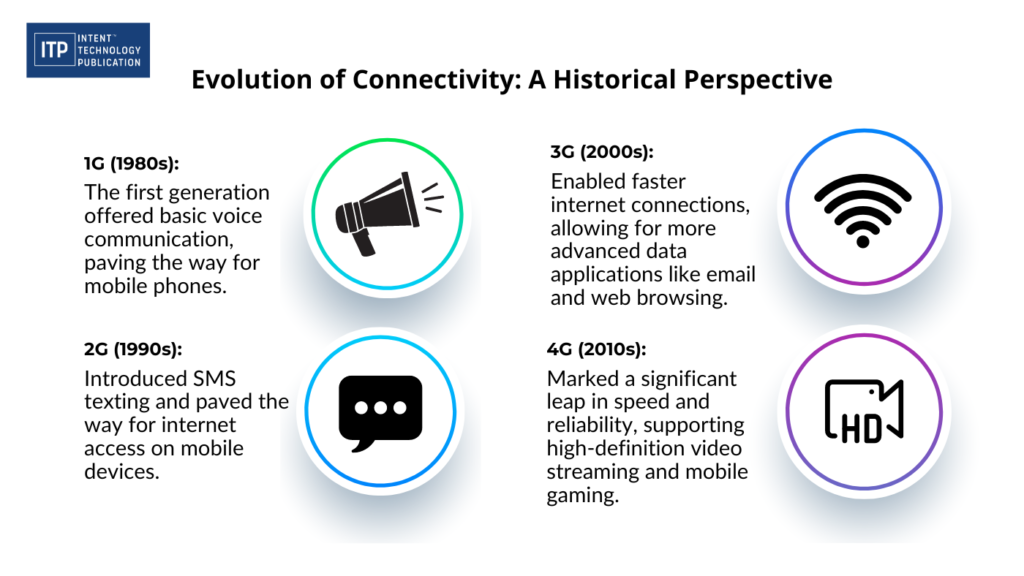or call: +1 (845) 347-8894

or call: +1 (845) 347-8894
or call: +1 (845) 347-8894

5G Technology, the fifth generation of wireless technology, represents a monumental leap forward in connectivity. Compared to its predecessor, 4G, 5G boasts significantly faster speeds (up to 100 times faster!), reduced latency (near-instantaneous response times), and increased capacity for handling numerous simultaneous connections. This translates to a transformative impact on the tech landscape, paving the way for a more connected, efficient, and innovative future.
In today’s tech-driven world, connectivity is the lifeblood of innovation. It fuels the exchange of data, facilitates collaboration, and enables the seamless functioning of countless applications. From streaming services to social media platforms, the Internet of Things (IoT) to autonomous vehicles, all rely heavily on robust and reliable connections. 5G, with its enhanced capabilities, serves as a game-changer, unlocking the full potential of existing technologies and propelling the development of entirely new ones.

Before diving into the revolutionary world of 5G Technology, let’s take a brief journey through the history of wireless technology:
The first generation offered basic voice communication, paving the way for mobile phones.
Introduced SMS texting and paved the way for internet access on mobile devices.
Enabled faster internet connections, allowing for more advanced data applications like email and web browsing.
Marked a significant leap in speed and reliability, supporting high-definition video streaming and mobile gaming.
5G represents a quantum leap from its predecessors. Its enhanced performance opens new possibilities across sectors, pushing the limits of what technology can achieve.
Download movies in seconds, enjoy seamless video conferencing with minimal delay and experience real-time responsiveness in applications.
Imagine a world where countless devices – from smartphones and laptops to smart appliances and self-driving cars – can connect simultaneously without experiencing congestion or lag. 5G makes this a reality, enabling the widespread adoption of the Internet of Things (IoT) and revolutionizing how we interact with our surroundings.
5G networks are designed to be more robust and efficient, offering improved stability and reduced energy consumption. This translates to reliable connectivity and a more sustainable future for technology.
The transformative power of 5G Technology extends far beyond individual users. It is poised to significantly impact several key industries:
The possibilities with 5G Technology are vast, and new applications are continuously emerging. Here are some exciting developments and use cases:
5G unlocks the potential for truly immersive AR and VR experiences, allowing users to interact with virtual objects and environments in real time with minimal lag. This opens doors for applications in various fields, including education, training, and entertainment.
Imagine surgeons practicing complex procedures in a realistic virtual environment or firefighters undergoing training simulations with enhanced detail and responsiveness, all thanks to the power of 5G-enabled VR.
While 5G presents incredible opportunities, it’s crucial to acknowledge the challenges and considerations:
A. Infrastructure Requirements:
Deploying a widespread and reliable 5G Technology requires significant infrastructure development, including installing new towers and upgrading existing systems. This can be a costly and time-consuming process.
B. Security and Privacy Concerns:
As with any new technology, security and privacy concerns remain paramount. Ensuring robust security measures are in place to safeguard sensitive data transmitted over 5G networks is essential.
The future of 5G is brimming with exciting possibilities. Here’s what we can anticipate:
A. Anticipated Advancements in 5G Technology:
Ongoing efforts aim to ensure seamless compatibility between different 5G networks and devices, paving the way for a more unified and globalized experience.
This innovative technology allows for the creation of virtual networks within the 5G infrastructure, catering to specific user needs and application requirements.
This technology, though facing some limitations in range, offers even faster speeds and higher capacity for specific applications like high-bandwidth data transfer.
The widespread adoption of 5G Technology will further accelerate the development of other emerging tech trends, including:
5G’s improved data transfer capabilities will fuel the advancement of AI applications by enabling faster processing of large datasets and real-time decision-making.
Secure and transparent data transmission through 5G Technology can facilitate the wider adoption of blockchain technology, enabling secure transactions and decentralized applications.
5G Technology marks a paradigm shift in the way we connect and interact with technology. Its transformative impact extends far beyond faster downloads, unlocking a world of possibilities across various industries and shaping the future of tech-driven innovation. As 5G continues to evolve, it’s crucial to stay informed about ongoing developments and embrace the opportunities it presents to create a more connected, efficient, and innovative future.
